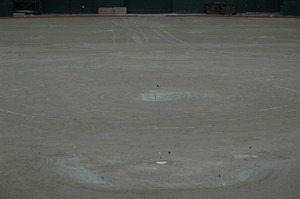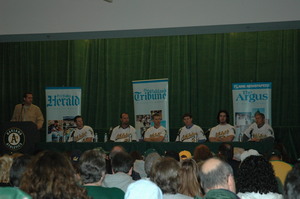


Baseball Toaster was unplugged on February 4, 2009.
Ken: catfish AT zombia d.o.t. com
Ryan: rarmbrust AT gmail d.o.t. com
Philip: kingchimp AT alamedanet d.o.t net
I feel about FanFests the way I feel about trade conferences: you spend all day at the thing, and if you're lucky, you find one or two useful pieces of information. Are those one or two things worth a day of your life? I'm never quite sure.
 I spent five and a half hours today at the Coliseum today, and came out with about five minutes worth of interesting stuff. I keep thinking there could be a more efficient use of my time, but for some reason, I keep going. At least the entrance fee is free, with my season ticket package. Plus, it provides a nice little emotional baseball fix in the middle of winter, if nothing else. Or so I tell myself.
I spent five and a half hours today at the Coliseum today, and came out with about five minutes worth of interesting stuff. I keep thinking there could be a more efficient use of my time, but for some reason, I keep going. At least the entrance fee is free, with my season ticket package. Plus, it provides a nice little emotional baseball fix in the middle of winter, if nothing else. Or so I tell myself.
I think the emotional fix would have been stronger if I had walked into the Coliseum today and seen a plush green field under a bright blue sky. Unfortunately, the grass had been completely removed. There was only drab gray dirt under a drab gray sky. Baseball still seemed to be deep in hibernation.
On the bright (or at least less drab) side, I had actually never seen the field completely bare like this, so I was provided with a new experience, even if it wasn't exactly a beautiful one.
* * *
 Another new experience was seeing some tarp installed over the third deck sections behind home plate. I wonder, are they going to install tarp over the whole third deck, or just those four sections? I hope it won't just be like this. The tarp layout looked off-center: they covered one middle section, one section on the first base side, and two sections on the third base side. Those of us who have even some minor Adrian Monk tendencies will be left haunted by the unevenness.
Another new experience was seeing some tarp installed over the third deck sections behind home plate. I wonder, are they going to install tarp over the whole third deck, or just those four sections? I hope it won't just be like this. The tarp layout looked off-center: they covered one middle section, one section on the first base side, and two sections on the third base side. Those of us who have even some minor Adrian Monk tendencies will be left haunted by the unevenness.
Seeing the third deck even partially covered makes me wonder something: if you're not going to use the third deck, could you move home plate a few feet closer to the seating bowl? Isn't it the angle of the third deck the main reason home plate needs to be so far away from the seats? Are there any other seats that would be obstructed by moving home plate back a foot or three? If one of the reasons for closing the third deck is to create a more intimate atmosphere, wouldn't effectively making everyone's seat one row closer to the action be more intimate?
You'd have to fiddle with the fences, and there's only about three feet of wiggle room in the corners, but the position of the outfield fences is already arbitrary.
* * *
I used to always enjoy the Billy Beane Q&A sessions, but my interest is starting to wane. I've seen his act enough now to know pretty much what he (isn't) going to say. This year was particularly uninteresting, because he didn't have to defend any controversial moves.
And yet...there was one new tidbit he dropped, almost in passing. He claimed that young players usually play quite inconsistently until sometime midway through their second season (Huston Street being a rare exception). He fully expects Nick Swisher and Dan Johnson to struggle at times in the first half of the year, and then sometime around midseason, things should start to click for them.
I'd never heard of that one-and-a-half-year rule of thumb before. I wonder if that idea is merely observational on Beane's part, or if he has some statistics backing that idea.
* * *
 The player Q&A sessions never really teach you anything about the game itself, but sometimes it can be fun to learn a little bit about the clubhouse chemistry. For example, who knew that Dan Haren was such a tease? Or that Kirk Saarloos is quite the wit? I had always imagined Frank Thomas as rather surly, but he seemed downright jovial in his Q&A session. Esteban Loaiza, who played with Thomas in Chicago, called Thomas "a big man, but a big teddy bear". Those were the most interesting words out of Loaiza's mouth, as otherwise he was a fountain of baseball cliches.
The player Q&A sessions never really teach you anything about the game itself, but sometimes it can be fun to learn a little bit about the clubhouse chemistry. For example, who knew that Dan Haren was such a tease? Or that Kirk Saarloos is quite the wit? I had always imagined Frank Thomas as rather surly, but he seemed downright jovial in his Q&A session. Esteban Loaiza, who played with Thomas in Chicago, called Thomas "a big man, but a big teddy bear". Those were the most interesting words out of Loaiza's mouth, as otherwise he was a fountain of baseball cliches.
Which brings us to the second interesting point of the day: that Thomas and Loaiza each said that they chose to sign with Oakland because they wanted to play for a winner. Normally, those are words reserved for teams like the Yankees and Red Sox--I can't ever recall anyone saying it about the A's before. Usually, the A's get free agents who are just happy to have a job. The A's have reached a new level of respect within baseball. If done right, it could be the start of a virtuous cycle: good players want to play for you, which makes you a good team, which makes more good players want to play for you.
* * *
In the afternoon, I eschewed the crowded player Q&As, and attended some more intimate seminars with A's coaches. There were a couple of "Baseball 101" sessions that dealt with how hitters and pitchers use video to maintain their mechanics and prepare for their opponents. Hitting coach Gerald Perry and catcher Adam Melhuse spoke about hitters, while pitching coach Curt Young and bullpen catcher Brandon Buckley talked about pitchers.
It was the combination of these two separate sessions that led to the third interesting thing I learned today: there is a sort of unspoken Hippocratic Oath that (A's) coaches follow: first, do no harm.
The mechanics of both hitting and pitching are subconscious--you want the hitter concentrating on the pitcher, and you want the pitcher concentrating on his target. You don't want a player thinking about his mechanics, because then he isn't concentrating on the thing he needs to concentrate on to succeed.
So there is a very real risk that by talking to a player about his mechanics, you can actually make things worse, because you can turn a subconscious act into a conscious one, and interrupt the automatic mechanism that brought them the success to reach this level.
Gerald Perry and Curt Young each spoke independently about not telling their pupils everything they notice. They choose what they talk to players about with great care. If they make a suggestion, they make sure to keep it a small and simple one, so that their conscious mind doesn't have too much information to hold. If you give a batter three different things to think about, by the time he thinks about those things, a fastball has gone right past him.
Earlier in the day, Dennis Eckersley was asked in a Q&A session why he was not a coach. Eck replied that it takes a special kind of person to coach, someone with a passion for it, and someone with patience. Eckersley admitted he did not have the patience to be an effective coach.
Coaching involves understanding technique, tactics, and psychology. You may see something that needs fixing, but you need the patience and understanding to know when and how to try to fix it, and when not to. Coaching is a delicate craft, and I don't think I fully appreciated that until today.
Behind the plate, the tarps will have this message, in gold lettering: HOME OF THE OAKLAND ATHLETICS. The years of the four Oakland World Series titles will be listed above the right-field corner, and the five championship years of the old Philadelphia A's will be seen above the left-field corner.
The four retired player numbers -- Catfish Hunter, Rollie Fingers, Reggie Jackson and Dennis Eckersley -- also will be shown.
Someone asked Young for some tips on teaching a kid how to pitch. He said to get some masking tape, make a strike zone on a wall, and throw a tennis ball against it until you can throw a strike every time. If you can do that, your mechanics are probably fine.
Comment status: comments have been closed. Baseball Toaster is now out of business.